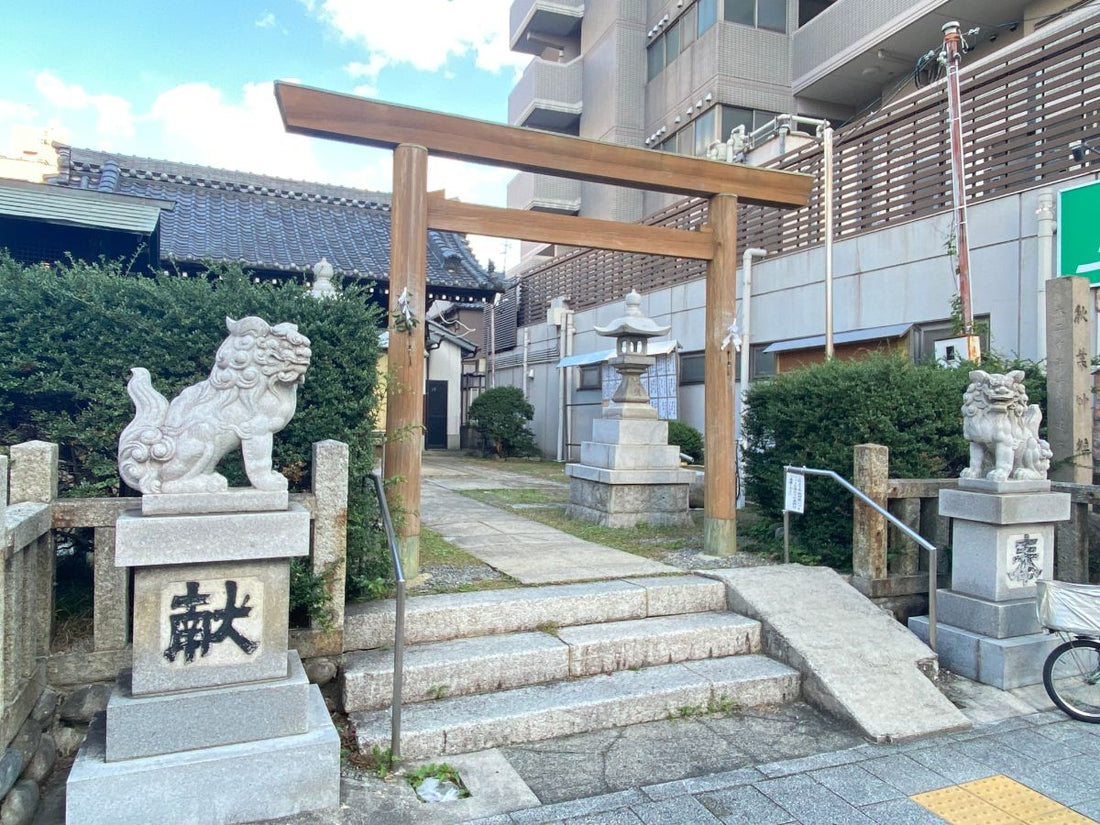
Nagoya Shrine Visit Report 2025 Mizuho No.9 Akiba Shrine
Share
Akiha Shrine in Nagoya — The Quiet Grove of the Fire Deity
Located in a quiet residential area of Mizuho Ward, Nagoya, Akiha Shrine is dedicated to the fire deity and has long protected the daily lives of local residents. Surrounded by houses and buildings, the moment you step through its gate, the air changes — calm and sacred. This small shrine preserves the atmosphere of an era when the town and the gods coexisted in everyday life.
Wooden Torii and Stone Guardians
At the entrance of the approach stands a warm wooden torii, instead of the more common stone type. Its smooth surface glows under the sunlight, adding a gentle presence to the grounds. On both sides stand a pair of granite guardian lions (komainu), carved with strength and delicate detail, inscribed with the characters “献” and “奉” meaning “dedication.” Together, the wooden torii and stone guardians create a beautifully balanced entrance.
Chozubachi — The Basin of Purification

To the right of the entrance lies a natural stone chozubachi (water basin) carved in a boat-like shape, with the word “奉納” (“offering”) engraved on it. A gentle flow of clear water continues endlessly. According to local tradition, it was offered by merchants in the early Shōwa period as a symbol of their wish to be protected from fire. Every drop still seems to carry that sincere prayer.
The Shrine Building

The main hall is a wooden structure with tiled roofing, showing the gentle sheen of aged timber. The onigawara roof ornaments bear motifs symbolizing protection from fire, and a small auxiliary shrine stands beside the main one. Stone lanterns and fences form a unified composition within the compact grounds, creating a peaceful yet dignified atmosphere. In the evening, local residents quietly stop to bow — a reminder that this place is not a tourist spot, but a shrine woven into daily prayer.
The Fire Deity and the Lineage of Akiha Faith
The principal deity, Hinokagutsuchi-no-Mikoto, has been revered since ancient times as the god who governs fire — both its blessings and its dangers. The broader Akiha faith originates from Akiha-san Hongū Akiha Shrine in Hamamatsu, Shizuoka Prefecture. From the Edo period onward, this faith spread widely among townspeople, carpenters, and merchants as protection against fire and for household safety. As the southern area of Nagoya was developed from former wetlands into new residential zones, this local shrine was founded as a guardian deity of fire prevention.
Expansion of the Akiha Faith and Its Sacred Mountain
The Akiha faith spread nationwide from Mount Akiha in Hamamatsu, Shizuoka, centered on Akiha-san Hongū Akiha Shrine. Today, about 1,100 shrines across Japan are associated with this faith. During the Edo period, it flourished as a popular belief among townspeople, carpenters, and merchants.
The main shrine stands atop Mount Akiha (866 meters above sea level), long revered as the “Grand Shrine of Fire.” According to legend, the mountain was first sanctified around 709 CE (Wadō 2) when ascetic monks enshrined the fire deity. Protected by the Tokugawa shoguns, the faith spread rapidly from Edo through Shinano, Owari, and Mino regions. By the late Edo period, pilgrimages known as “Akiha-mode” became as popular as those to Ise and Konpira, making Mount Akiha one of the three great folk pilgrimage sites of the era. From Hamamatsu, this devotion spread throughout Japan — a culture of fire reverence and safety that continues to this day.
A Local Legend of the Wooden Torii
According to local lore, a master carpenter once asked to build the shrine’s torii in wood instead of stone. Though he feared fire, he carved the gate by hand, channeling his pride as a craftsman into the material he knew best. That wooden torii still stands today, its grain preserving his spirit of gratitude and devotion.
Chronology (based on verified historical records)
| Year / Period | Event |
|---|---|
| 710 CE | Hinokagutsuchi-no-Mikoto appears in the Kojiki and Nihon Shoki, marking the beginning of fire deity worship. |
| Edo period (17th–19th century) | As the southern area of Nagoya was developed, Akiha Shrine was believed to be founded as a guardian against fire (exact year unknown). |
Deities Enshrined
| Deity | Reading | Divine Role |
|---|---|---|
| Hinokagutsuchi-no-Mikoto | ひのかぐつちのみこと | Deity of fire. Protects from fire and ensures household safety. |
| Akiha-no-Ōkami | あきはのおおかみ | Personification of fire protection; symbolizes the Akiha faith. |
Notable Akiha Shrines in Japan
| Name | Location | Notes |
|---|---|---|
| Akiha-san Hongū Akiha Shrine | Hamamatsu, Shizuoka Prefecture | Main shrine of the Akiha faith. Center of over 1,100 affiliated shrines nationwide. |
| Akiha Shrine (Shinjuku, Tokyo) | 1-9 Yaraichō, Shinjuku Ward | Representative urban Akiha shrine in the capital. |
| Akiha Shrine (Niigata City) | 3-8-19 Akiha, Niigata City | Regional guardian deity for the Akiha District. |
| Akiha Shrine (Kakamigahara, Gifu) | 2-403 Kaminakaya-chō, Kakamigahara City | Major Akiha shrine in the Gifu area. |
| Akiha Shrine (Hitachi, Ibaraki) | 1-11-3 Tajiri-chō, Hitachi City | Represents the spread of Akiha faith in northern Kanto. |
Conclusion — Stones That Carry Japan’s Prayer
Japan is said to have about 80,000 shrines, each dedicated to a different deity and preserving local forms of worship. At JapanStones.shop, we personally visit such shrines, photograph their stone works, and share authentic Japanese stone craftsmanship with people around the world.
The scenery of Akiha Shrine — where wood and stone stand together — quietly reflects the spirit of “prayer and craftsmanship” that has long been cherished in Japan. Though modest in scale, this small shrine embodies a form of faith that endures, becoming one tangible page in the story of stone that connects Japan to the world.
